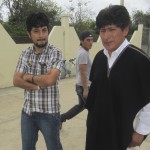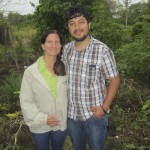 Runak Kunapak Yachai on Santa Cruz, Galapagos, is a school for indigenous children. Indigenous Ecuadoreans refers to the people from the highlands on the mainland, the people of the Andes. They are considered a minority in the Galapagos. A group of parents got together to form the school as they were not happy with the education their children were receiving in the local school and were particularly interested in preserving aspects of their culture, especially their language which is Quichua. Non indigenous children are also welcome at the school. All the students learn in both Spanish and Quichua.
Runak Kunapak Yachai on Santa Cruz, Galapagos, is a school for indigenous children. Indigenous Ecuadoreans refers to the people from the highlands on the mainland, the people of the Andes. They are considered a minority in the Galapagos. A group of parents got together to form the school as they were not happy with the education their children were receiving in the local school and were particularly interested in preserving aspects of their culture, especially their language which is Quichua. Non indigenous children are also welcome at the school. All the students learn in both Spanish and Quichua.
The school is in a bank building and needs to relocate to larger premises. 164 students from kindergarten to grade 6 attend in two session, the 2 older grades come in the afternoon due to lack of classrooms. I met the Head, David, who has been with the school since it first opened. David, a qualified teacher, moved from the Andes with his family, during a time of economic hardship, to work in the construction industry. He was persuaded by the local indigenous community to open and run a new school, 7 years ago. He agreed despite being only paid a very low salary due to the school initially not being recognized by the Ecuadorian Education Department. The school is now officially recognized and the staff are paid award salaries, plus extra for being on Galapagos, however the school facilities are still somewhat lacking.
I asked David what his biggest challenges were. He echoed some of the issues that Daniel raised with me (see article here on Un Cambio por la Vida). His biggest concern is the lack of “direct parent”. In most cases both parents work. Many parents come home for almorzo (lunch – the most important meal) and then go back to work in the mid afternoon until quite late. The school does its best to offer some afternoon activities but they have limited resources to do so and some teachers are reluctant to work beyond the normal hours.
It is also extremely difficult to organize meetings with parents. He has tried to hold meetings on weekends but then faces opposition from the staff. I asked David if the parents were working so long due to economic necessity. He thinks this is not the case for all. He sees it as part of the Andean culture to work long hours, the difference here being that they are no longer working the land and involving their family. Daniel sees it as a Galapogean problem– work hard, buy lots of new things.
David has a big heart and an even bigger job. He teaches a class full time as well as runs the whole school. The school has two specialist teachers who have dual roles. The Quechua teacher is also the IT teacher and the physical education teacher is also the English teacher. I asked David if he ever has gap students or other volunteers. He said yes but they typically only come for 2 – 3 weeks. This surprised me! This is a useless amount of time and cannot be good for the kids. David was not sure of the name of the organization that arranges this and I expressed my skepticism at such a program. I suggested he should look into having longer term volunteers to assist with English lessons or other specialty areas.
It is Daniel’s hope that through his organization “Un Cambio por la Vida”, that he can run a volunteer program for suitable candidates to come to the Galapagos for a minimum of 6 months to do work in the schools as well as help with the Tiera de Niños program. I see many possibilities here and we discussed this at length over lunch. (Watch this space!)
 Thomas de Berlanga School is quite a contrast to the indigenous school. It is a private, fee paying school with 183 students from K-12, founded 19 years ago by a group of concerned parents seeking an alternative education for their children. They formed the organization “Fundacion Scalesia” which is also responsible for scholarships and financial assistance for about 30% of the students attending the school. It is 4 km inland from Port Ayora, in what the locals call “the highlands”. It lies in a beautiful natural setting with lots of outdoor areas and lava gravel paths. The classrooms have a very open feel, are made from natural materials and use mostly nature light. I met the Head, a dynamic American lady who has been an Ecuadorean for over 20 years. Sheila told me that the main aim of the school is to have students interact with nature and teach them through nature. All teachers are committed to this and achieve this in various creative ways. She said to me it was a great pity that even on this beautiful island, the schools are just concrete blocks. On the drive back to town, Sheila showed me several schools which were just as she described.
Thomas de Berlanga School is quite a contrast to the indigenous school. It is a private, fee paying school with 183 students from K-12, founded 19 years ago by a group of concerned parents seeking an alternative education for their children. They formed the organization “Fundacion Scalesia” which is also responsible for scholarships and financial assistance for about 30% of the students attending the school. It is 4 km inland from Port Ayora, in what the locals call “the highlands”. It lies in a beautiful natural setting with lots of outdoor areas and lava gravel paths. The classrooms have a very open feel, are made from natural materials and use mostly nature light. I met the Head, a dynamic American lady who has been an Ecuadorean for over 20 years. Sheila told me that the main aim of the school is to have students interact with nature and teach them through nature. All teachers are committed to this and achieve this in various creative ways. She said to me it was a great pity that even on this beautiful island, the schools are just concrete blocks. On the drive back to town, Sheila showed me several schools which were just as she described.
The national curriculum has recently been reformed after an extensive national survey. One of the things the survey revealed was that children in Ecuador were able to identify animals such as giraffes and elephants but not their own endemic species. The curriculum has now had regional specific sections added to it and Sheila showed me the section specific to the Galapagos in a grade 4 science workbook.
Sheila, myself and David had an interesting discussion about education in the Galapagos and I am very grateful for both of them being so generous with their time. I learnt a lot and many ideas were generated. It is a very interesting school with its own set of challenges but it is refreshing to see the commitment and dedication towards environmental issues and specific problems associated with the region. The whole “vibe” of the school was inspiring and Sheila is a passionate and very hard working leader.
Links
The current state of education in the Galapagos: Galapagos Conservancy
http://www.galapagos.org/about_galapagos/education/ (English)
La Fundación Scalesia, Galapagos
http://fundacionscalesia.com/index.html (Spanish)

One Response to Two schools on Santa Cruz: Galapagos